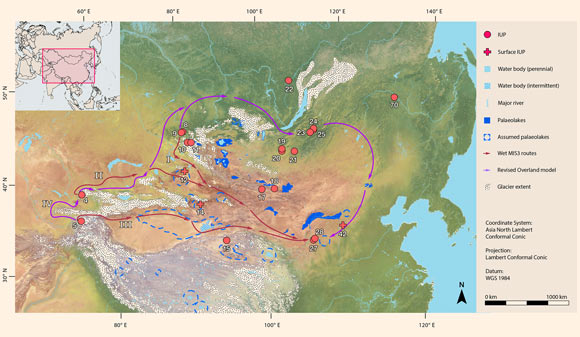New research demonstrates that Asian regions such as the Gobi Desert and the Altai Mountains could have periodically acted as corridors and routes for Late Pleistocene human dispersals and framing interactions between hominin populations.

Ancient humans. Image credit: sjs.org / CC BY-SA 3.0.
After leaving Africa, Homo sapiens dispersed across the Asian continent during the Late Pleistocene, but it isn’t known exactly what routes our species followed.
Most models assume that the Gobi Desert and Altai Mountain chains of North and Central Asia formed impassable barriers on the way to the east, so archaeological exploration has tended to neglect those regions in favor of seemingly more likely paths farther north and south.
In the new study, Dr. Feng Li from China’s Institute of Vertebrate Paleontology and Paleoanthropology and colleagues used Geographic Information Systems (GIS) software alongside archaeological and paleoclimate data to reconstruct the conditions of North and Central Asia over the Late Pleistocene and to identify possible routes of travel.
Their results suggest that the desert and mountain regions were likely impassable during cold and dry glacial periods. But during warmer and wetter interglacial times, it would have been possible for human populations to traverse these regions via at least three routes following ancient lake and river systems.

Illustrated dispersal routes from the results of the Least Cost Path analysis: the three routes from the ‘wet’ simulations and the single route from the ‘dry’ simulation are presented together in conjunction with paleoclimatic extents (glaciers and paleolakes). I – ‘Altai’ route, II – ‘Tian Shan’ Route, III – ‘Tarim’ route, IV – “Revised Overland’ route. Image credit: Li et al, doi: 10.1371/journal.pone.0216433.
“Our data do not demonstrate definite routes of dispersal. More detailed models should be constructed to test these results,” Dr. Li and co-authors said.
“However, these models do identify specific routes that may be good candidates for future archaeological exploration.”
Understanding the timing and tempo of Homo sapiens dispersal across Asia will be crucial for determining how culture and technology spread and developed, as well as how our species interacted with our extinct cousins, the Neanderthals and Denisovans.
“Our modeling of the available geographic and past climate data suggest that archaeologists and anthropologists should look for early human presence, migration, and interaction with other hominins in new parts of Asia that have been neglected as static voids,” said Dr. Patrick Roberts, a researcher at the Max Planck Institute for the Science of Human History and the University of Queensland.
“Given what we are increasingly discovering about the flexibility of our species, it would be of no surprise if we were to find early Homo sapiens in the middle of modern deserts or mountainous glacial sheets all across Asia. Indeed, it may be here that the key to our species’ uniqueness lies.”
The findings were published in the journal PLoS ONE.
_____
Feng Li et al. 2019. Heading north: Late Pleistocene environments and human dispersals in central and eastern Asia. PLoS ONE 14 (5): e0216433; doi: 10.1371/journal.pone.0216433







